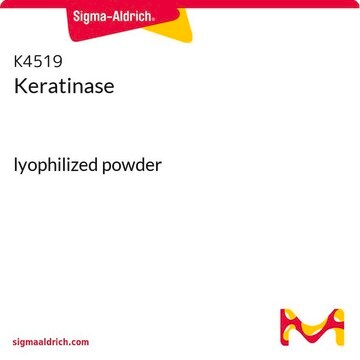D3571
Dipeptidyl Peptidase III human
recombinant, expressed in Sf9 cells
Synonym(s):
DPP III
Sign Into View Organizational & Contract Pricing
All Photos(1)
About This Item
UNSPSC Code:
12352204
NACRES:
NA.54
Recommended Products
recombinant
expressed in Sf9 cells
Quality Level
form
solution
specific activity
≥400 units/μg protein
mol wt
82 kDa
concentration
≥0.1 mg/mL
shipped in
dry ice
storage temp.
−70°C
Gene Information
human ... DPP3(10072)
Related Categories
Application
Human dipeptidyl peptidase III has been used in a study to assess the effect of entropy-driven binding of opioid peptides on large domain motion in human dipeptidyl peptidase III. Human dipeptidyl peptidase III has also been used in a study to investigate Ets-1/Elk-1 as a critical mediator of its transcription in human glioblastoma cells.
Biochem/physiol Actions
DPP III is a cytosolic zinc-exopeptidase that is involved in the intracellular protein catabolism of eukaryotes. The enzyme is a monomeric acidic protein with a molecular mass of approximately 82,000 Da and a pI of 4.5-4.6. It is sensitive to freezing and temperatures above 40 °C. It is found to be inhibited by metallo-chelators and sulfydryl reagents. The activity can be restored by divalent cations and thiol compounds. It has a particularly high affinity for angiotensin III. It acts as a post-proline-cleaving enzyme on endomorphins.
Unit Definition
One unit will hydrolyze 1.0 picomole of Arg-Arg-AMC per minute at pH 7.5 at 25 deg °C
Physical form
Supplied as a solution in 45 mM Tris-HCl, pH 8.0, 124 mM NaCl, 2.4 mM KCl, 18 mM glutathione, 10% glycerol and 3 mM DTT.
Storage Class
12 - Non Combustible Liquids
wgk_germany
WGK 1
flash_point_f
Not applicable
flash_point_c
Not applicable
Certificates of Analysis (COA)
Search for Certificates of Analysis (COA) by entering the products Lot/Batch Number. Lot and Batch Numbers can be found on a product’s label following the words ‘Lot’ or ‘Batch’.
Already Own This Product?
Find documentation for the products that you have recently purchased in the Document Library.
Antonija Tomić et al.
Journal of molecular recognition : JMR, 24(5), 804-814 (2011-08-04)
Human dipeptidyl peptidase III (DPP III) is a zinc-exopeptidase with implied roles in protein catabolism, pain modulation, and defense against oxidative stress. To understand the mode of ligand binding into its active site, we performed molecular modeling, site-directed mutagenesis, and
Marina Barsun et al.
Biological chemistry, 388(3), 343-348 (2007-03-07)
Dipeptidyl peptidase III (DPP III) is a zinc exopeptidase with an implied role in the mammalian pain-modulatory system owing to its high affinity for enkephalins and localisation in the superficial laminae of the spinal cord dorsal horn. Our study revealed
Ashleigh M Philp et al.
International journal of molecular sciences, 22(13) (2021-07-03)
Obesity increases the risk of hip osteoarthritis (OA). Recent studies have shown that adipokine extracellular nicotinamide phosphoribosyltransferase (eNAMPT or visfatin) induces the production of IL-6 and matrix metalloproteases (MMPs) in chondrocytes, suggesting it may promote articular cartilage degradation. However, neither
Abhay A Shukla et al.
The FEBS journal, 277(8), 1861-1875 (2010-03-20)
Dipetidyl-peptidase III is a metallopeptidase involved in a number of physiological processes and its expression has been reported to increase with the histological aggressiveness of human ovarian primary carcinomas. Because no information regarding the regulation of its expression was available
Simon Stenberg et al.
eLife, 11 (2022-07-09)
Deletion of mitochondrial DNA in eukaryotes is currently attributed to rare accidental events associated with mitochondrial replication or repair of double-strand breaks. We report the discovery that yeast cells arrest harmful intramitochondrial superoxide production by shutting down respiration through genetically
Our team of scientists has experience in all areas of research including Life Science, Material Science, Chemical Synthesis, Chromatography, Analytical and many others.
Contact Technical Service






